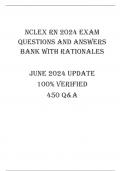NCLEX RN 2024 EXAM
QUESTIONS AND ANSWERS
BANK WITH RATIONALES
JUNE 2024 UPDATE
100% VERIFIED
450 Q&A
,1. 1. Question
1 point(s)
Category: Health Promotion and Maintenance
Mrs. Chua, a 78-year-old client, is admitted with the diagnosis of mild chronic
heart failure. The nurse expects to hear when listening to client’s lungs indicative
of chronic heart failure would be:
o A. Stridor
o B. Crackles
o C. Wheezes
o D. Friction rubs
Correct Answer: B. Crackles
Left-sided heart failure causes fluid accumulation in the capillary network of the
lung. Fluid eventually enters alveolar spaces and causes crackling sounds at the
end of inspiration. Pulmonary edema may cause crackling sounds in the lungs.
People with congestive heart failure (CHF) often have pulmonary edema. CHF
occurs when the heart cannot pump blood effectively. This results in a backup of
blood, which increases blood pressure and causes fluid to collect in the air sacs in
the lungs.
Option A: Stridor may result from lesions involving the central nervous
system (CNS), the cardiovascular system, the gastrointestinal (GI) tract, or
the respiratory tract. When air passes through a narrowed flexible airway in
a child, the lateral pressure that holds the airway open can drop
precipitously (the Bernoulli principle) and cause the tube to close. This
process obstructs airflow and produces stridor.
Option C: The most common causes of wheezing are asthma and chronic
obstructive pulmonary disease (COPD), which both cause narrowing and
spasms (bronchospasms) in the small airways of the lungs. However, any
inflammation in the throat or larger airways can cause wheezing. Common
causes include infection, an allergic reaction or a physical obstruction, such
as a tumor or a foreign object that’s been inhaled.
Option D: A pericardial friction rub is pathognomonic for acute
pericarditis; the rub has a scratching, grating sound similar to leather
, rubbing against leather. Serial examinations may be necessary for
detection, as a friction rub may be transient from one hour to the next and
is present in approximately 50% of cases.
2. 2. Question
1 point(s)
Category: Pharmacological and Parenteral Therapies
Patrick who is hospitalized following a myocardial infarction asks the nurse why
he is taking morphine. The nurse explains that morphine:
A. Decrease anxiety and restlessness
B. Prevents shock and relieves pain
C. Dilates coronary blood vessels
D. Helps prevent fibrillation of the heart
Correct Answer: B. Prevents shock and relieves pain
Morphine is a central nervous system depressant used to relieve the pain
associated with myocardial infarction, it also decreases apprehension and
prevents cardiogenic shock. FDA-approved usage of morphine sulfate includes
moderate to severe pain that may be acute or chronic. Most commonly used in
pain management, morphine provides major relief to patients afflicted with pain.
Option A: Benzodiazepines decrease anxiety and restlessness. Indications
for benzodiazepine administration include, but are not limited to, anxiety
disorders, insomnia, acute status epilepticus, induction of amnesia, spastic
disorders, seizure disorders, and agitation.
Option C: Calcium channel blockers, such as nitroglycerin, dilate large
coronary blood vessels. The dihydropyridines, in therapeutic dosing, have a
little direct effect on the myocardium, and instead, are more often
peripheral vasodilators, which is why they are useful for hypertension, post-
intracranial hemorrhage associated vasospasm, and migraines.
Option D: Antiplatelets and anticoagulants help prevent atrial fibrillation
by preventing blood clot formation. Antiplatelet medications divide into
oral and parenteral agents. Oral agents subdivide further based on the
mechanism of action. Aspirin was the first antiplatelet medication and is a
cyclooxygenase inhibitor.
, 3. 3. Question
1 point(s)
Category: Pharmacological and Parenteral Therapies
Which of the following should the nurse teach the client about the signs of
digitalis toxicity?
A. Increased appetite
B. Elevated blood pressure
C. Skin rash over the chest and back
D. Visual disturbances such as seeing yellow spots
Correct Answer: D. Visual disturbances such as seeing yellow spots
Seeing yellow spots and colored vision are common symptoms of digitalis
toxicity. Of note visual changes especially changes involving colors such as seeing
a yellow hue are better known and specifically seen in digitalis toxicity. Other
visual problems include photophobia, photopsia and diminished visual acuity.
Option A: GI symptoms of digitalis toxicity include anorexia and weight
loss. Most symptoms are nonspecific findings and include a headache,
malaise, insomnia, altered mental status, abdominal pain, nausea, and
vomiting.
Option B: Hypotension is one of the cardiac symptoms of digitalis toxicity.
There is no specific arrhythmia for digoxin toxicity rather a range of
arrhythmias can be present such as various degrees of AV block, premature
ventricular contractions, bradycardia, and even ventricular tachycardia.
Cardiac arrhythmias are the main cause of death for those with digoxin
toxicity.
Option C: There are no skin rashes in patients with digitalis toxicity. History
of exposure is necessary to determine if poisoning is acute or chronic. Most
reported poisonings result from chronic toxicity. Clinical signs of toxicity
include gastrointestinal, neurological and the most concerning cardiac.
4. 4. Question
1 point(s)
Category: Pharmacological and Parenteral Therapies




